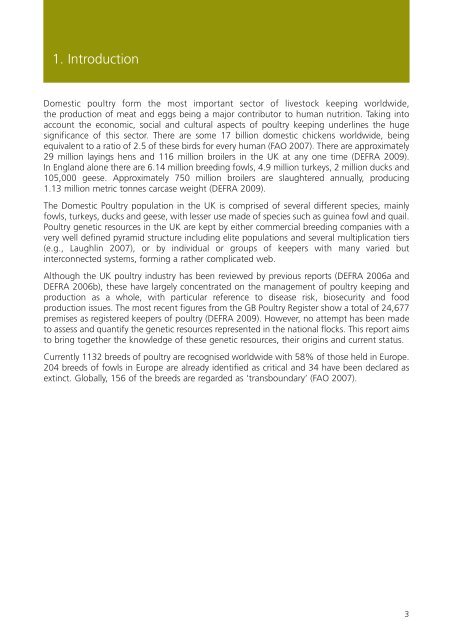Poultry in the United Kingdom - Defra
Poultry in the United Kingdom - Defra
Poultry in the United Kingdom - Defra
Create successful ePaper yourself
Turn your PDF publications into a flip-book with our unique Google optimized e-Paper software.
1. Introduction<br />
Domestic poultry form <strong>the</strong> most important sector of livestock keep<strong>in</strong>g worldwide,<br />
<strong>the</strong> production of meat and eggs be<strong>in</strong>g a major contributor to human nutrition. Tak<strong>in</strong>g <strong>in</strong>to<br />
account <strong>the</strong> economic, social and cultural aspects of poultry keep<strong>in</strong>g underl<strong>in</strong>es <strong>the</strong> huge<br />
significance of this sector. There are some 17 billion domestic chickens worldwide, be<strong>in</strong>g<br />
equivalent to a ratio of 2.5 of <strong>the</strong>se birds for every human (FAO 2007). There are approximately<br />
29 million lay<strong>in</strong>gs hens and 116 million broilers <strong>in</strong> <strong>the</strong> UK at any one time (DEFRA 2009).<br />
In England alone <strong>the</strong>re are 6.14 million breed<strong>in</strong>g fowls, 4.9 million turkeys, 2 million ducks and<br />
105,000 geese. Approximately 750 million broilers are slaughtered annually, produc<strong>in</strong>g<br />
1.13 million metric tonnes carcase weight (DEFRA 2009).<br />
The Domestic <strong>Poultry</strong> population <strong>in</strong> <strong>the</strong> UK is comprised of several different species, ma<strong>in</strong>ly<br />
fowls, turkeys, ducks and geese, with lesser use made of species such as gu<strong>in</strong>ea fowl and quail.<br />
<strong>Poultry</strong> genetic resources <strong>in</strong> <strong>the</strong> UK are kept by ei<strong>the</strong>r commercial breed<strong>in</strong>g companies with a<br />
very well def<strong>in</strong>ed pyramid structure <strong>in</strong>clud<strong>in</strong>g elite populations and several multiplication tiers<br />
(e.g., Laughl<strong>in</strong> 2007), or by <strong>in</strong>dividual or groups of keepers with many varied but<br />
<strong>in</strong>terconnected systems, form<strong>in</strong>g a ra<strong>the</strong>r complicated web.<br />
Although <strong>the</strong> UK poultry <strong>in</strong>dustry has been reviewed by previous reports (DEFRA 2006a and<br />
DEFRA 2006b), <strong>the</strong>se have largely concentrated on <strong>the</strong> management of poultry keep<strong>in</strong>g and<br />
production as a whole, with particular reference to disease risk, biosecurity and food<br />
production issues. The most recent figures from <strong>the</strong> GB <strong>Poultry</strong> Register show a total of 24,677<br />
premises as registered keepers of poultry (DEFRA 2009). However, no attempt has been made<br />
to assess and quantify <strong>the</strong> genetic resources represented <strong>in</strong> <strong>the</strong> national flocks. This report aims<br />
to br<strong>in</strong>g toge<strong>the</strong>r <strong>the</strong> knowledge of <strong>the</strong>se genetic resources, <strong>the</strong>ir orig<strong>in</strong>s and current status.<br />
Currently 1132 breeds of poultry are recognised worldwide with 58% of those held <strong>in</strong> Europe.<br />
204 breeds of fowls <strong>in</strong> Europe are already identified as critical and 34 have been declared as<br />
ext<strong>in</strong>ct. Globally, 156 of <strong>the</strong> breeds are regarded as ‘transboundary’ (FAO 2007).<br />
3

















